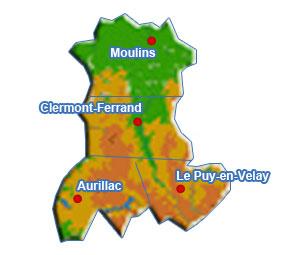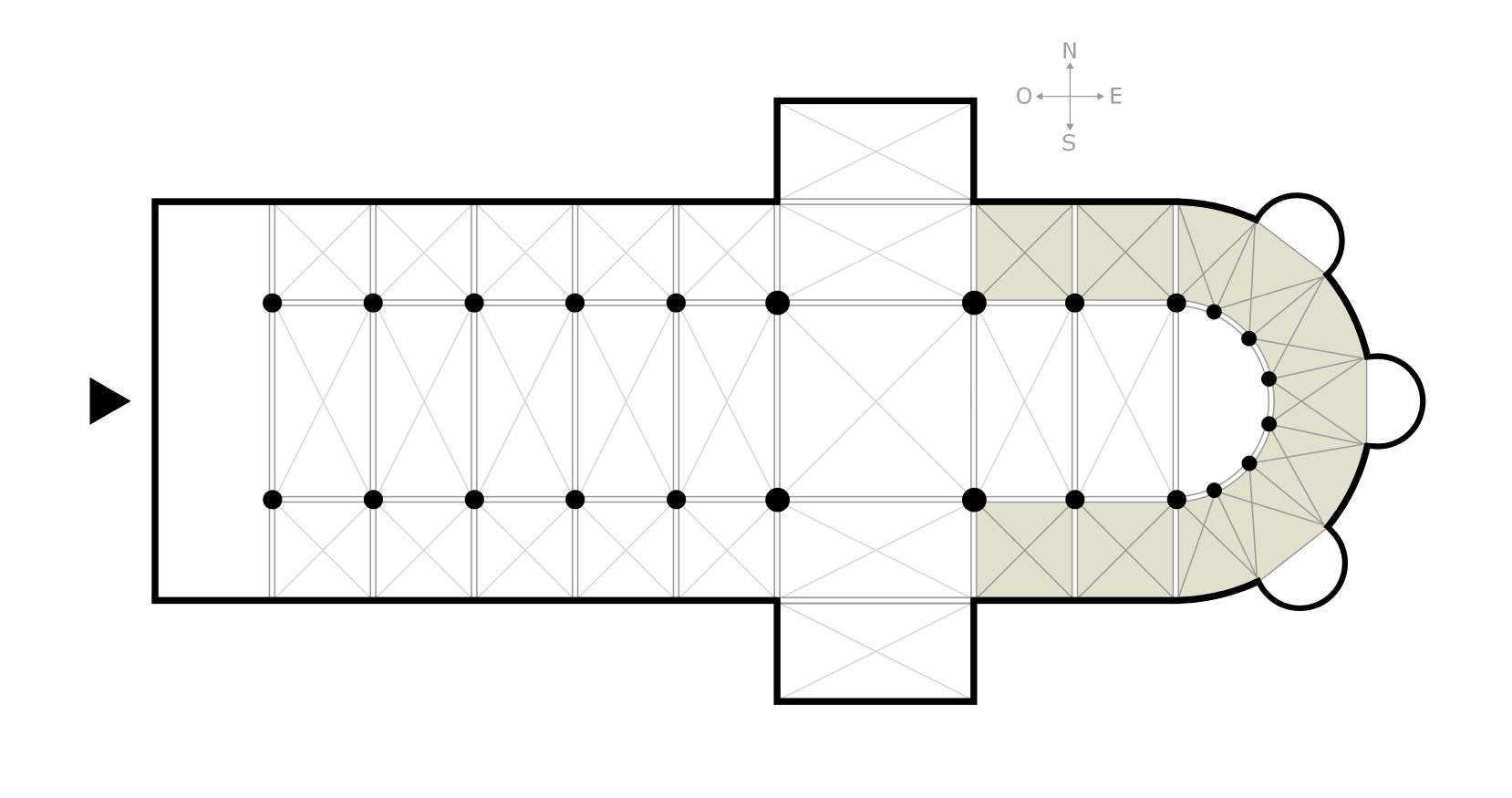|
Fanum D'Aron
Fanum d'Aron is a fanum, or Romano-Celtic temple, located in Aurillac, a French commune in the Auvergne region. Site and status Discovered in 1970 in the southwest of Aurillac, the temple was excavated from May 1977 through the end of 1978 and added to the ''monuments historiques'' registry in 1980. It is situated in what is now a small municipal garden, between a pavilion and the Lescudilier industrial zone (cadastre BE n°360). History Salvage excavations have recovered rich materials from the site, including lapidary pieces, glass and metallic artifacts, coins, eight column capitals (four of which feature sculpted trachyte heads representing the Sun and Moon), a fluted column barrel fragment, and ceramics as well as terracotta antefixes. These objects establish that the temple would have been in use from the 1st to 3rd centuries CE. Some artifacts and architectural elements from the site are kept on display at the Aurillac Museum of Art and Archeology, along with ... [...More Info...] [...Related Items...] OR: [Wikipedia] [Google] [Baidu] |
Auvergne
Auvergne (; ; oc, label=Occitan, Auvèrnhe or ) is a former administrative region in central France, comprising the four departments of Allier, Puy-de-Dôme, Cantal and Haute-Loire. Since 1 January 2016, it has been part of the new region Auvergne-Rhône-Alpes.. The administrative region of Auvergne is larger than the historical province of Auvergne, one of the seven counties of Occitania, and includes provinces and areas that historically were not part of Auvergne. The Auvergne region is composed of the following old provinces: * Auvergne: departments of Puy-de-Dôme, Cantal, northwest of Haute-Loire, and extreme south of Allier. The province of Auvergne is entirely contained inside the Auvergne region * Bourbonnais: department of Allier. A small part of Bourbonnais lies outside Auvergne, in the neighbouring Centre-Val de Loire region (south of the department of Cher). * Velay: centre and southeast of department of Haute-Loire. Velay is entirely contained inside the Auvergne r ... [...More Info...] [...Related Items...] OR: [Wikipedia] [Google] [Baidu] |
Trachyte
Trachyte () is an extrusive igneous rock composed mostly of alkali feldspar. It is usually light-colored and aphanitic (fine-grained), with minor amounts of mafic minerals, and is formed by the rapid cooling of lava enriched with silica and alkali metals. It is the volcanic equivalent of syenite. Trachyte is common wherever alkali magma is erupted, including in late stages of ocean island volcanismMacDonald 1983, pp. 51-52 and in continental rift valleys, above mantle plumes,Philpotts and Ague 2009, pp. 390-394 and in areas of back-arc extension. Trachyte has also been found in Gale crater on Mars. Trachyte has been used as decorative building stone and was extensively used as dimension stone in the Roman Empire and the Republic of Venice. Chemical composition Trachyte has a silica content of 60 to 65% and an alkali oxide content of over 7%. This gives it less SiO2 than rhyolite and more (Na2O plus K2O) than dacite. These chemical differences are consistent with the positio ... [...More Info...] [...Related Items...] OR: [Wikipedia] [Google] [Baidu] |
Mauriac, Cantal
Mauriac (; ) is a commune in the Cantal department in the Auvergne region in south-central France. It lies north-northwest of Aurillac by rail. Mauriac, built on the slope of a volcanic hill, has a medieval church, and the buildings of an old abbey now used as public offices and dwellings; the town owes its origin to the abbey, which originated from a 6th-century foundation. Geography Mauriac is situated in the northwest of Cantal, close to the border with the Corrèze and Limousin departments. The greater part of the Mauriac arrondissement is watered by the Saint-Jean, a brook which flows past the southwestern edge of the town and fills the lac du Val Saint-Jean, a small reservoir, before flowing into Auze, an important tributary of the Dordogne. Mauriac is in hilly terrain, with the main populated area falling into a zone at an altitude of about 350–450 metres, while the surrounding areas rise to about 760 metres in the volcanic foothills. History Childebert, daught ... [...More Info...] [...Related Items...] OR: [Wikipedia] [Google] [Baidu] |
Vellavi
The Vellavii (Gaulish: *''Uellauī/Wellawī'') were a Gallic tribe dwelling around the modern city of Le Puy-en-Velay, in the region of the Auvergne, during the Iron Age and the Roman period. Name They are mentioned as ''Vellaviis'' (var. ''vellabiis'') by Caesar (mid-1st c. BC), ''Ou̓ellaoúioi'' (Οὐελλαούιοι, var. -άοιοι, -άϊοι) by Strabo (early 1st c. AD), ''Vellavi'' (var. ''velavi'') by Pliny (1st c. AD), ''Ou̓éllaunoi'' (Οὐέλλαυνοι, var. Οὐέλλενες) by Ptolemy (2nd c. AD), and as ''Velavorum'' in the ''Notitia Dignitatum'' (5th c. AD).''Notitia Dignitatum'', oc 42:68., s.v. ''Vellavi''. The city of Le-Puy-en-Velay, attested ca. 400 AD as ''civitas Villavorum'' ('civitas of the Vellavii'), and the region of Velay, attested in 845 as ''pagus Vellaicus'' ('pagus In ancient Rome, the Latin word (plural ) was an administrative term designating a rural subdivision of a tribal territory, which included individual farms, villages ( ... [...More Info...] [...Related Items...] OR: [Wikipedia] [Google] [Baidu] |
Terracotta
Terracotta, terra cotta, or terra-cotta (; ; ), in its material sense as an earthenware substrate, is a clay-based ceramic glaze, unglazed or glazed ceramic where the pottery firing, fired body is porous. In applied art, craft, construction, and architecture, terracotta is the term normally used for sculpture made in earthenware and also for various practical uses, including bowl (vessel), vessels (notably flower pots), water and waste water pipes, tile, roofing tiles, bricks, and surface embellishment in building construction. The term is also used to refer to the natural Terra cotta (color), brownish orange color of most terracotta. In archaeology and art history, "terracotta" is often used to describe objects such as figurines not made on a potter's wheel. Vessels and other objects that are or might be made on a wheel from the same material are called earthenware pottery; the choice of term depends on the type of object rather than the material or firing technique. Unglazed ... [...More Info...] [...Related Items...] OR: [Wikipedia] [Google] [Baidu] |
Corinthian Capitals
The Corinthian order (Greek: Κορινθιακός ρυθμός, Latin: ''Ordo Corinthius'') is the last developed of the three principal classical orders of Ancient Greek architecture and Roman architecture. The other two are the Doric order which was the earliest, followed by the Ionic order. In Ancient Greek architecture, the Corinthian order follows the Ionic in almost all respects other than the capitals of the columns. When classical architecture was revived during the Renaissance, two more orders were added to the canon: the Tuscan order and the Composite order. The Corinthian, with its offshoot the Composite, is the most ornate of the orders. This architectural style is characterized by slender fluted columns and elaborate capitals decorated with acanthus leaves and scrolls. There are many variations. The name ''Corinthian'' is derived from the ancient Greek city of Corinth, although the style had its own model in Roman practice, following precedents set by the Templ ... [...More Info...] [...Related Items...] OR: [Wikipedia] [Google] [Baidu] |
Acanthus (plant)
''Acanthus'' is a genus of about 30 species of flowering plants in the family Acanthaceae, native to tropical and warm temperate regions, with the highest species diversity in the Mediterranean Basin and Asia. This flowering plant is nectar producing and is susceptible to predation by butterflies, such as ''Anartia fatima'', and other nectar feeding organisms. Common names include Acanthus and Bear's breeches. The generic name derives from the Greek term (''akanthos'') for ''Acanthus mollis'', a plant that was commonly imitated in Corinthian capitals. The genus comprises herbaceous perennial plants, rarely subshrubs, with spiny leaves and flower spikes bearing white or purplish flowers. Size varies from in height. Selected species *'' Acanthus arboreus'' Forssk. (1775) *'' Acanthus austromontanus'' Vollesen *''Acanthus balcanicus'' Heywood & I.Richardson ( Syn. ''Acanthus hungaricus'' ( Borbás) Baenitz, ''Acanthus longifolius'' Host) — native to the Balkans south of Dalma ... [...More Info...] [...Related Items...] OR: [Wikipedia] [Google] [Baidu] |
Cère
The Cère is a long river in south-western France, left tributary of the Dordogne. Its source is in the south-western Massif Central, near the mountain Plomb du Cantal. It flows generally west through the following ''départements'' and towns: * Cantal: Vic-sur-Cère, Arpajon-sur-Cère (near Aurillac) * Corrèze * Lot: Bretenoux The Cère flows into the Dordogne near Bretenoux Bretenoux (; oc, Bertenor) is a commune in the Lot department in southwestern France. Geography Location The ''Bastide'' is located north of the Lot, near the border with the Corrèze department, in the Dordogne Valley, Bretenoux is attached t .... References Image:Gorges de la Cere 1900-2.jpg, The Cère gorge close to Laroquebrou Rivers of France Rivers of Auvergne-Rhône-Alpes Rivers of Occitania (administrative region) Rivers of Nouvelle-Aquitaine Rivers of Corrèze Rivers of Lot (department) Rivers of Cantal {{France-river-stub ... [...More Info...] [...Related Items...] OR: [Wikipedia] [Google] [Baidu] |
Ambulatory
The ambulatory ( la, ambulatorium, ‘walking place’) is the covered passage around a cloister or the processional way around the east end of a cathedral or large church and behind the high altar. The first ambulatory was in France in the 11th century but by the 13th century ambulatories had been introduced in England and many English cathedrals were extended to provide an ambulatory. The same feature is often found in Indian architecture and Buddhist architecture generally, especially in older periods. Ritual circumambulation or parikrama around a stupa or cult image is important in Buddhism and Hinduism. Often the whole building was circumambulated, often many times. The Buddhist chaitya hall always allowed a path for this, and the Durga temple, Aihole (7th or 8th century) is a famous Hindu example. The term is also used to describe a garden feature in the grounds of a country house. A typical example is the one shown, which stands in the grounds of Horton Court in Gloucest ... [...More Info...] [...Related Items...] OR: [Wikipedia] [Google] [Baidu] |
Cella
A cella (from Latin for small chamber) or naos (from the Ancient Greek, Greek ναός, "temple") is the inner chamber of an ancient Greek temple, Greek or Roman temple in classical antiquity. Its enclosure within walls has given rise to extended meanings, of a Monastery, hermit's or monk's cell, and since the 17th century, of a Cell (biology), biological cell in plants or animals. Greek and Roman temples In ancient Greek temple, Greek and Roman temples the cella was a room at the center of the building, usually containing a cult image or statue representing the particular deity venerated in the temple. In addition, the cella may contain a table to receive supplementary votive offerings such as votive statues of associated deities, precious and semi-precious stones, helmets, spear and arrow heads, swords, and war trophy, war trophies. No gatherings or sacrifices took place in the cella as the altar for sacrifices was always located outside the building along the axis and tempora ... [...More Info...] [...Related Items...] OR: [Wikipedia] [Google] [Baidu] |
Third Century
The 3rd century was the period from 201 ( CCI) to 300 ( CCC) Anno Domini (AD) or Common Era (CE) in the Julian calendar.. In this century, the Roman Empire saw a crisis, starting with the assassination of the Roman Emperor Severus Alexander in 235, plunging the empire into a period of economic troubles, barbarian incursions, political upheavals, civil wars, and the split of the Roman Empire through the Gallic Empire in the west and the Palmyrene Empire in the east, which all together threatened to destroy the Roman Empire in its entirety, but the reconquests of the seceded territories by Emperor Aurelian and the stabilization period under Emperor Diocletian due to the administrative strengthening of the empire caused an end to the crisis by 284. This crisis would also mark the beginning of Late Antiquity. In Persia, the Parthian Empire was succeeded by the Sassanid Empire in 224 after Ardashir I defeated and killed Artabanus V during the Battle of Hormozdgan. The Sassan ... [...More Info...] [...Related Items...] OR: [Wikipedia] [Google] [Baidu] |


.jpg)
.jpg)

